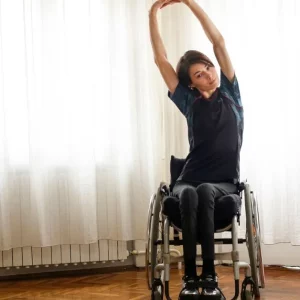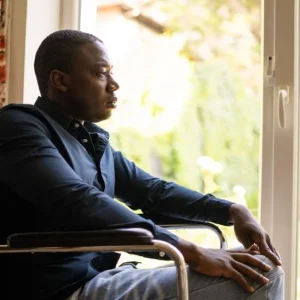A cervical spinal cord injury (SCI) is a serious, life-threatening emergency that can cause paralysis and loss of sensation throughout the entire body. Depending on the level and severity of a cervical spinal cord injury, it can affect major body functions like breathing and mobility from your neck down.
This article will help you understand what to expect after a cervical SCI by guiding you through the functions affected at each level of injury. Use the links below to jump straight to any section:
Understanding Cervical Spinal Cord Injury
The cervical spinal cord is the uppermost region of the spinal cord that primarily makes up the area along your neck. Because the cervical region bears less weight and has a greater range of motion than lower parts of the spine, it tends to be less stable and more vulnerable to injury. As a result, almost 60% of all spinal cord injuries result in cervical-level injuries.
The cervical region of the spinal cord consists of 8 levels that communicate with different areas of the body. Specifically, each level of the cervical spinal cord sends and receives signals regarding movement and sensation in the neck, arms and hands.
However, after a cervical spinal cord injury, individuals will experience loss of motor control and/or sensation throughout the arms, trunk, and legs. This occurs because signals from the brain cannot pass through damaged areas of the spinal cord.
As a result, sensory and motor functions below the level of injury can also be affected. Since the majority of the body can potentially be affected, the road to recovery is often longer for individuals with cervical spinal cord injuries compared to those with lower level injuries.

Fortunately, there is often hope for individuals to recover affected functions. The severity of a spinal cord injury can play a significant role in determining outcomes. One way to assess the severity of a SCI is to determine whether it is a complete or incomplete injury.
A complete spinal cord injury refers to damage that transects the entire spinal cord. As a result, no connections between the brain and areas below the level of injury exist, resulting in complete loss of functions below the level of injury.
In contrast, an incomplete spinal cord injury only partially transects the spinal cord, leaving some spared or unaffected connections between the brain and areas below the level of injury. As a result, some (but not all) signals can be transmitted past the level of injury and individuals may be able to move or have sensation in areas below their level of injury.
Along with loss of motor control and sensation, individuals may experience additional effects. The following section will discuss various secondary effects of cervical spinal cord injury.
Effects of Cervical Spinal Cord Injury
Depending on the severity and level of your injury, cervical spinal cord injuries can affect a wide variety of functions.
Survivors of cervical spinal cord injury may experience difficulties in following areas:
- Breathing
- Mobility from the neck down
- Sensation from the neck down
- Fine motor skills
- Balance
- Coordination
- Bladder and bowel control
- Sexual functions
- Gait
- Posture
- Sweating
- Circulation
- Body temperature regulation
Each spinal cord injury is unique and may result in various secondary effects. By taking a personalized approach to treatment and addressing complications individually, individuals can significantly improve their quality of life.
To help you get a better idea of what to expect at each level of injury, the following section will discuss which sensory and motor functions may be affected each level.
What to Expect at Each Level of Cervical Spinal Cord Injury

Each level of cervical spinal cord injury will directly affect a different set of muscles and area of skin. Level of injury is determined by the lowest area where sensory and motor functions are unaffected.
Below, you can find information on your specific level of injury based on the international standards for neurological classification.
C1 Spinal Cord Injury
C1 spinal cord injury is the most serious type of cervical spinal injury. Injury at this level has the potential cause the most widespread loss of function. In fact, C1 SCIs are often fatal because individuals may lose the ability to breathe. Luckily, this level of injury is rare and only makes up only about 1.2% of all SCIs.
After a C1 spinal cord injury, the following may occur:
- Paralysis from the neck down
- Inability to breathe independently (will require ventilator assistance)
- Need full caregiver assistance due to extremely limited mobility
- Communication difficulties (ability to talk can be affected)
Learn more about C1 spinal cord injury »
C2 Spinal Cord Injury
Because the C1 and C2 spinal nerves are closely aligned, C2 spinal cord injuries often result in similar outcomes. Along with the C1 vertebrae, the C2 vertebrae helps support the head and provide the neck with a greater range of motion than the rest of the spine.
After a C2 spinal cord injury, the following can result:
- Paralysis from the neck down
- Inability to breathe independently (will require ventilator assistance)
- Need full assistance of a caregiver
- Limited speaking ability
Read more about C2 spinal cord injury »
C3 Spinal Cord Injury
The C3-C5 spinal nerves connect to the diaphragm, which is the main muscle involved in breathing. Individuals with C3 spinal cord injuries will generally have motor control and sensation in their neck.
The following may occur as a result of a C3 spinal cord injury:
- Improved head and neck control (after spinal cord damage has stabilized)
- Intact neck side flexion (the ability to tilt your head to the side)
- Loss of independent breathing (will require ventilator assistance)
- Paralysis of the arms, legs and trunk
Discover more about C3 spinal cord injury »
C4 Spinal Cord Injury
After a C4 spinal cord injury, individuals may only require temporary ventilator assistance because some parts of the diaphragm are unaffected. With the help of breathing and coughing exercises, many individuals can wean off the ventilator and regain independent breathing.
Other outcomes of C4 spinal cord injury include:
- Full head and neck mobility
- Partial shoulder mobility
- Breathing difficulties/ weakness
Learn more about C4 spinal cord injuries »
C5 Spinal Cord Injury
C5 spinal nerves directly affect sensation around the outer area of the upper arm. Additionally, the C5 spinal nerves connect to the deltoids (which are responsible for shoulder movement), biceps, and brachioradialis (which are responsible for elbow flexion and upward rotation of the forearm).
Individuals with C5 spinal cord injuries may experience the following:
- Normal head, neck, and shoulder movements
- Intact sensation at head, neck, shoulders, and outer upper arms
- Ability to raise the arms and bend the elbows
- Breathing weakness (but usually no need for ventilator assistance)
Read more about C5 spinal cord injuries »
C6 Spinal Cord Injury
After a C6 spinal cord injury, individuals usually retain most arm mobility. With the help of specialized adaptive tools like grip attachments, individuals with a C6 spinal cord injury should be able to perform everyday tasks like eating, grooming, and getting dressed on their own.
Some positive outcomes of C6 spinal cord injury include:
- Preservation of head, neck, and shoulder movements
- Ability to raise the arms, bend the elbows, flip hand palm up and palm down, and extend the wrists
- Normal sensation in the head, neck, shoulders, and outer areas of the arms
- Ability to use tenodesis grasp patterns
Find out more about C6 spinal cord injuries »
C7 Spinal Cord Injury
Due to increased mobility of the upper extremities, individuals with a C7 spinal cord injury generally have a great deal of independence. With a C7 level of injury, individuals retain motor control of their arm and hand but are unable to fully bend the fingers.
A person with a C7 spinal cord injury should be able to:
- feel sensations at the head, neck, shoulder, arms, index fingers, and thumbs
- demonstrate full range of motion in the shoulders and neck
- raise the arms
- bend and straighten the elbows
- bend and straighten the wrists
- extend the fingers
Learn more about C7 spinal cord injuries »
C8 Spinal Cord Injury
Lastly, we’ll discuss what to expect after a C8 spinal cord injury.
Generally, individuals with a C8 SCI can carry out activities of daily living on their own because the majority of their upper body functions are unaffected. After a C8 spinal cord injury, individuals can expect:
- Full range of motion in the wrists, elbows, shoulders, and neck
- Hand weakness
- Normal sensation in the fingers, arms, shoulders, neck, and head
People with a C8 SCI should practice hand exercises to help recover strength and dexterity in their fingers.
Discover more about C8 spinal cord injuries»
Is it Possible to Recover from Cervical Spinal Cord Injury?
For many, there is hope for recovery after cervical spinal cord injury. While damaged regions of the spinal cord are unable to heal themselves, unaffected regions at the level of injury have the potential to utilize neuroplasticity.
Neuroplasticity refers to the central nervous system’s ability to make adaptive changes and reorganize its neural circuitry. It allows for functions affected by cervical spinal cord injuries to be rewired to unaffected regions and relearned through repetitive, task-specific practice. This is why participating in rehabilitative therapies like physical and occupational therapy after SCI is essential.
Every time you perform a movement, it stimulates the spinal cord. Consistent practice helps reinforce demand for that movement and encourages the spinal cord to utilize neuroplasticity to reorganize itself. The more you practice, the stronger the new pathways for that function become.
Unfortunately, only spared neural pathways are capable of utilizing neuroplasticity, which means only individuals with incomplete spinal cord injuries have the potential to recover. However, that does not mean there is no room for improvement for individuals with complete SCIs.
Rehabilitative therapies for complete SCI will focus on maximizing the individual’s functional independence and mobility. This may involve learning alternative ways to perform everyday tasks such as using adaptive tools or using unaffected areas of the body to compensate for paralyzed areas.
While compensatory strategies are the main focus of complete SCI rehabilitation currently, there are promising new treatment options being researched, such as stem cell therapy, to help even those with complete spinal cord injuries regain functions.
Understanding Cervical Spinal Cord Injury
Cervical spinal cord injuries are the most common type of spinal cord injuries. Depending on the level of injury, cervical SCIs can directly affect mobility in the neck, arms, and fingers. They often can result in trunk and lower body paralysis, depending on the severity of injury.
As you’ve just learned, higher-level cervical SCIs have very different functional and sensory outcomes than lower-level injuries. Additionally, less severe spinal cord lesions will result in fewer impairments. As a result, you may still be able to feel and control areas of your body that are connected below your level of injury.
Individuals with incomplete cervical spinal cord injuries have the potential to recover affected functions and improve their mobility by participating in highly repetitive, targeted exercise. Consistently practicing affected movements helps reinforce demand for those functions and encourage the spinal cord to make adaptive changes.
We hope this article helped you understand what to expect after a cervical spinal cord injury and that there is hope for recovery.











